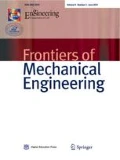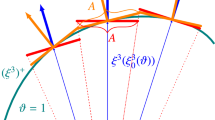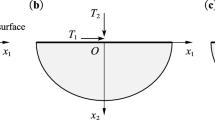Abstract
As a widely used numerical method, boundary element method (BEM) is efficient for computer aided engineering (CAE). However, boundary integrals with near singularity need to be calculated accurately and efficiently to implement BEM for CAE analysis on thin bodies successfully. In this paper, the distance in the denominator of the fundamental solution is first designed as an equivalent form using approximate expansion and the original sinh method can be revised into a new form considering the minimum distance and the approximate expansion. Second, the acquisition of the projection point by Newton-Raphson method is introduced. We acquire the nearest point between the source point and element edge by solving a cubic equation if the location of the projection point is outside the element, where boundary integrals with near singularity appear. Finally, the subtriangles of the local coordinate space are mapped into the integration space and the sinh method is applied in the integration space. The revised sinh method can be directly performed in the integration element. Averification test of our method is proposed. Results demonstrate that our method is effective for regularizing the boundary integrals with near singularity.
Similar content being viewed by others
References
Liu Y. Fast Multipole Boundary Element Method: Theory and Applications in Engineering. Cambridge: Cambridge University Press, 2009
Feng S, Cui X, Li A. Fast and efficient analysis of transient nonlinear heat conduction problems using combined approximations (CA) method. Transfer, 2016, 97: 638–644
Feng S, Cui X, Chen F, et al. An edge/face-based smoothed radial point interpolation method for static analysis of structures. Engineering Analysis with Boundary Elements, 2016, 68: 1–10
Feng S, Cui X, Li G. Analysis of transient thermo-elastic problems using edge-based smoothed finite element method. International Journal of Thermal Sciences, 2013, 65: 127–135
Feng S, Cui X, Li G. Transient thermal mechanical analyses using a face-based smoothed finite element method (FS-FEM). International Journal of Thermal Sciences, 2013, 74: 95–103
Cui X, Liu G, Li G. A cell-based smoothed radial point interpolation method (CS-RPIM) for static and free vibration of solids. Engineering Analysis with Boundary Elements, 2010, 34(2): 144–157
Cui X, Feng S, Li G. A cell-based smoothed radial point interpolation method (CS-RPIM) for heat transfer analysis. Engineering Analysis with Boundary Elements, 2014, 40: 147–153
Cheng A H D, Cheng D T. Heritage and early history of the boundary element method. Engineering Analysis with Boundary Elements, 2005, 29(3): 268–302
Gao X. The radial integration method for evaluation of domain integrals with boundary-only discretization. Engineering Analysis with Boundary Elements, 2002, 26(10): 905–916
Gao X, Davies T G. Adaptive integration in elasto-plastic boundary element analysis. Journal of the Chinese Institute of Engineers, 2000, 23(3): 349–356
Zhang J, Qin X, Han X, et al. A boundary face method for potential problems in three dimensions. International Journal for Numerical Methods in Engineering, 2009, 80(3): 320–337
Niu Z, Wendland W, Wang X, et al. A sim-analytic algorithm for the evaluation of the nearly singular integrals in three-dimensional boundary element methods. Computer Methods in Applied Mechanics and Engineering, 2005, 31: 949–964
Niu Z, Zhou H. The natural boundary integral equation in potential problems and regularization of the hypersingular integral. Computers & Structures, 2004, 82(2–3): 315–323
Zhou H, Niu Z, Cheng C, et al. Analytical integral algorithm in the BEM for orthotropic potential problems of thin bodies. Engineering Analysis with Boundary Elements, 2007, 31(9): 739–748
Zhou H, Niu Z, Cheng C, et al. Analytical integral algorithm applied to boundary layer effect and thin body effect in BEM for anisotropic potential problems. Computers & Structures, 2008, 86(15–16): 1656–1671
Lv J, Miao Y, Zhu H. The distance sinh transformation for the numerical evaluation of nearly singular integrals over curved surface elements. Computational Mechanics, 2014, 53(2): 359–367
Ma H, Kamiya N. A general algorithm for accurate computation of field variables and its derivatives near the boundary in BEM. Engineering Analysis with Boundary Elements, 2001, 25(10): 833–841
Ma H, Kamiya N. Distance transformation for the numerical evaluation of near singular boundary integrals with various kernels in boundary element method. Engineering Analysis with Boundary Elements, 2002, 26(4): 329–339
Ma H, Kamiya N. Nearly singular approximations of CPV integrals with end-and corner-singularities for the numerical solution of hypersingular boundary integral equations. Engineering Analysis with Boundary Elements, 2003, 27(6): 625–637
Hayami K, Matsumoto H. A numerical quadrature for nearly singular boundary element integrals. Engineering Analysis with Boundary Elements, 1994, 13(2): 143–154
Hayami K. Variable transformations for nearly singular integrals in the boundary element method. Publications of the Research Institute for Mathematical Sciences, 2005, 41(4): 821–842
Zhang Y, Gu Y, Chen J. Boundary layer effect in BEM with high order geometry elements using transformation. Computer Modeling in Engineering and Sciences, 2009, 45(3): 227–247
Zhang Y, Gu Y, Chen J. Boundary element analysis of the thermal behaviour in thin-coated cutting tools. Engineering Analysis with Boundary Elements, 2010, 34(9): 775–784
Xie G, Zhang J, Qin X, et al. New variable transformations for evaluating nearly singular integrals in 2D boundary element method. Engineering Analysis with Boundary Elements, 2011, 35 (6): 811–817
Xie G, Zhang J, Dong Y, et al. An improved exponential transformation for nearly singular boundary element integrals in elasticity problems. International Journal of Solids and Structures, 2014, 51(6): 1322–1329
Johnston P R, Elliott D. A sinh transformation for evaluating nearly singular boundary element integrals. International Journal for Numerical Methods in Engineering, 2005, 62(4): 564–578
Johnston B M, Johnston P R, Elliott D. A sinh transformation for evaluating two-dimensional nearly singular boundary element integrals. International Journal for Numerical Methods in Engineering, 2007, 69(7): 1460–1479
Gu Y, Chen W, Zhang C. Stress analysis for thin multilayered coating systems using a sinh transformed boundary element method. International Journal of Solids and Structures, 2013, 50(20–21): 3460–3471
Gu Y, Chen W, He X. Improved singular boundary method for elasticity problems. Computers & Structures, 2014, 135: 73–82
Lv J, Miao Y, Gong W, et al. The sinh transformation for curved elements using the general distance function. Computer Modeling in Engineering & Sciences, 2013, 93(2): 113–131
Author information
Authors and Affiliations
Corresponding authors
Rights and permissions
About this article
Cite this article
Xie, G., Zhang, D., Zhang, J. et al. Implementation of sinh method in integration space for boundary integrals with near singularity in potential problems. Front. Mech. Eng. 11, 412–422 (2016). https://doi.org/10.1007/s11465-016-0396-8
Received:
Accepted:
Published:
Issue Date:
DOI: https://doi.org/10.1007/s11465-016-0396-8




